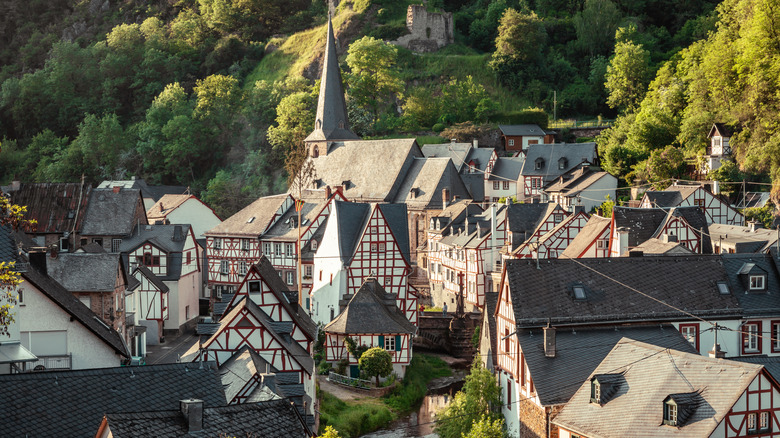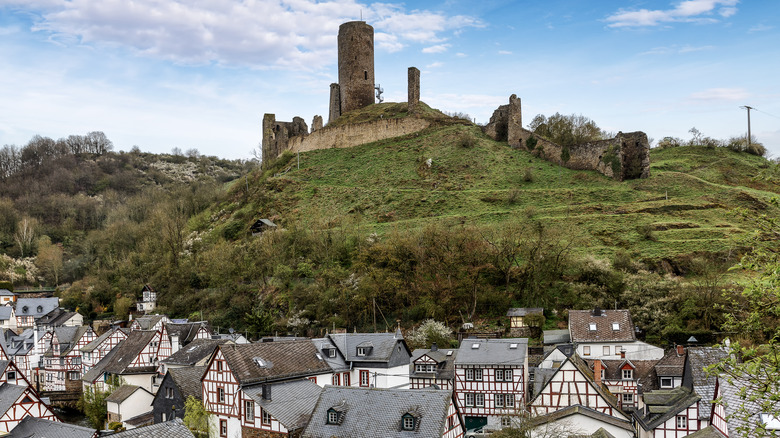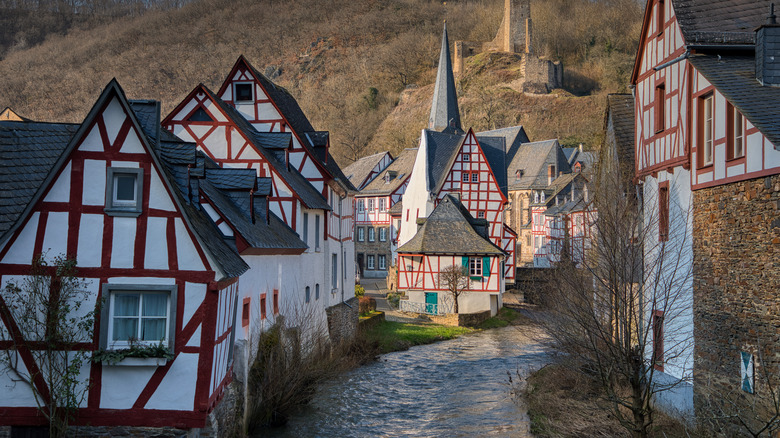The Underrated German Town That's Straight Out Of 'Beauty And The Beast'
Tucked away in the southwest region of Germany — north of the Moselle Valley and south of the bustling city of Cologne – is Monreal, a romantic, riverside village where the hilltop ruins of two castles loom over a network of cobblestone streets and red and white half-timbered houses. Here, visitors are transported to a fairytale setting, reminiscent of the village dreamed up in the Disney classic "Beauty and the Beast."
Monreal is located in Germany's Eifel region, a sparsely populated area known for its low mountain range, medieval castles, and picturesque villages. Eifel National Park is a major draw for visitors who enjoy its dense forests of gnarled oaks, meadows of daffodils, and clear lakes.The medieval town of Monschau, with a population of about 12,000, attracts the most attention of all the villages in the region. In comparison, the much smaller Monreal, which has around 800 residents, is considered a hidden gem. The smaller hamlet still has lots to offer any tourists looking to be transported — if not into a fictional world, then at least to an earlier time.
Early summer is the best time of year to visit Germany, but if you're visiting Monreal during the holiday season, you'll be able to shop at the small Christmas market, called "Monrealer Krippenweg," that takes over the village's historic square in late December and early January. While it's not like the huge Christmas markets of major European cities, Monreal's quaint celebration offers a glimpse into how locals bring light and merriment to this time of year.
Visit the medieval ruins overlooking Monreal
First, an excursion to Monreal isn't complete without a hike up the hill to see the ruins of its two castles: Löwenburg Castle and Philippsburg Castle. The history of Löwenburg Castle, often referred to simply as Monreal Castle, can be traced back to 1229. It's a spur castle, meaning a medieval castle built on the "spur" of a hill or mountain as a defensive advantage. The massive castle walls were once 10 feet thick — a feature that can still be seen from its ruins.
The smaller Philippsburg Castle, a mere five-minute walk from Löwenburg, was also built in the 13th century, but its original purpose remains unclear. One story goes that a fight between two brothers led to the creation of both structures. To see the ruins, there are multiple routes to get there. The easiest is to park at 19 Untertorstraße in the upper part of town and take a walking path up to the ruins of Löwenburg. Take a right where the path forks for the easiest walk, which is about 950 feet.
If you have more of an appetite for adventure, you could see the ruins while hiking the Monrealer Ritterschlag — an 8.4-mile trail that loops around the village, past the castle ruins, and through dense wooded areas. It's designated as a difficult hike that could take up to five hours to complete, but it's one of Germany's best. "A real dream path – beautifully laid out and varied paths and fantastic panoramas," one hiker wrote on AllTrails. While on the trail, hikers will pass Café Altes Pfarrhaus Monreal, which serves up drinks, cakes, and breakfast foods out of an old 19th century Catholic rectory.
Stroll through the fairytale town of Monreal
Walking is one of the main activities in Monreal, a village so picturesque that visitors like to explore and photograph every storefront and winding alley. A historic stone bridge over the Elz River is a popular stop, as is the town's church. The Catholic Parish Church of the Holy Trinity is a quaint building made of local quarry stone and open to visitors. Its tower rises above all of the other structures in town.
While you're wandering through the village, you can learn something about the structures you're seeing. Many of the half-timber houses are adorned with plaques, each describing that home's history. The signs are in German, so be ready to translate (or brush up on your words and phrases to know before your trip to Germany). One describes the home of a weaver in the early modern period. Another describes a large manor home that was built in the 18th century, when Monreal's weaving industry created an era of prosperity for the small village.
After all that walking, you'll likely be ready for a bite to eat. In addition to Café Altes Pfarrhaus Monreal, the village boasts another spot for pastries and drinks: Café Plüsch. One visitor to Monreal said on TripAdvisor that a stop at the café was "ideal after climbing to the castle." Another described it as a "cocoon of human warmth," where they took refuge while it rained outside. The cakes are the café's specialty. One visitor wrote that "anyone who loves cakes and tarts must go to Café Plüsch."


